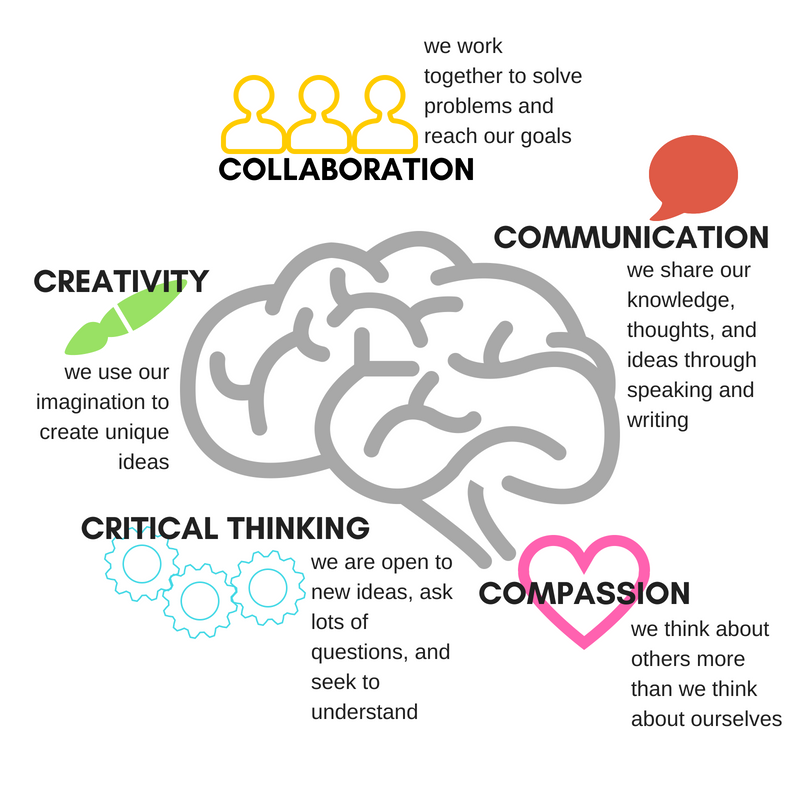Make It 5
Education buzzwords come and go like the wind. Veteran teachers often refer to the constant swing of the educational pendulum. It’s easy to fall into the trap of thinking that this is just another thing coming round circle. But I’m here to tell you the 4 Cs of education: Collaboration, Critical Thinking, Creativity, Communication, are not going anywhere, anytime soon. These heavily researched skills (see p21.org) are foundational to the future of our students. These skills encourage the application of knowledge, which requires students to work at a higher cognitive level.
All that being said, I believe there is one component missing from the 4 Cs… Compassion! The four of these 21st-century skills can be used to make a positive change in our world, but not without compassion. In my classroom, students say, “Compassion: when we think about others more than we think about ourselves.”
 Kid-friendly definitions of the 5 Cs used in Mrs. Jankord’s classroom.
Kid-friendly definitions of the 5 Cs used in Mrs. Jankord’s classroom.
Communication
When students hear the word communication, they automatically think public speaking or presenting in front of the class. Communication is not just the ability to share your own thinking. In order to be a great communicator, one has to be a good listener. Compassion is at the core of being a good listener, you have to care for and value others enough to pause and listen attentively. Empathy allows us to take their thoughts and really understand where they are coming from; or as my students say, put yourself in their shoes. And when we truly listen to others we come out with enriched ideas.
Critical Thinking
Being a good listener does not mean we have to accept all beliefs, and opinions as our own. Critical thinking allows us to evaluate and make judgments about what we hear, see, and learn. If we are selfish in our thinking, critical thinking can lead to some poor ideation. Critical Thinking + Compassion allows us to put each idea and opinion in a special light of considering others. Not all critical thinking leads to a world-changing moment, for example, if I am using critical thinking to solve a math problem, the answer may not affect anyone. But Critical Thinking can be intense, it can be stressful, and can cause brain overload. In those tense moments, students with compassion may consider emotional regulation strategies instead of exploding on their collaborating partners.
Collaboration
Often collaboration follows these two skills. They have shared ideas and they have listened to ideas. They have evaluated the information and they have brainstormed possible solutions. They are ready to collaborate. This past week I used my best Gollum voice and impersonated how some students feel about their personal ideas, “precious, my idea is precious.” After a good laugh, I told my students it’s important to brainstorm ideas in our own quiet thinking space, but we cannot get too attached. Ultimately, when two brains come together it’s more powerful than a single person’s thoughts. When a team comes together to collaborate, they have to create a solution everyone can agree on (or at least live with). Putting ideas together, testing them out, and failing is hard. Without compassion, we fall victim to the blame game or trying to justify ourselves. In our school, we call this living below the line (8 Keys of Excellence). Compassion is key in failing forward.
Creativity
Using our imagination often gets crushed somewhere along the path of life. Unfortunately, it’s often been education that has squashed the life out of creativity. But I truly believe we are taking a turn for the good in this department. Innovation requires a creative mind, so we must teach and harness a child’s creativity. We have to be careful to nurture and not turn down the wild, crazy ideas of children. For example, one of my students this past week told me if we ever had a zombie apocalypse she would “invent a drone that could drill into the center of the earth and detect radiation from the zombies anywhere around the world. It would then somehow attract the zombies to a certain point and apply serum to heal the zombie.” There are several things in the above scenario that may leave you scratching your head. Instead of saying, “umm… that doesn’t make any sense,” I said, “Wow, I like how you are thinking.” I’m going to leave it to her to work out the details and fail a few times. She will eventually figure out, on her own, that she may need to refine some of the details in her plan. It is often failures that lead to successes. Ultimately, it takes me having compassion for others and allowing for their creativity without crushing their hopes and dreams. Compassion is what drives creative ideas that lead to the cure for cancer or how to solve the Great Pacific Garbage Patch.
The 4 Cs in a 21st Century classroom: Communication, Critical Thinking, Collaboration, Creativity, add Compassion and make it 5.